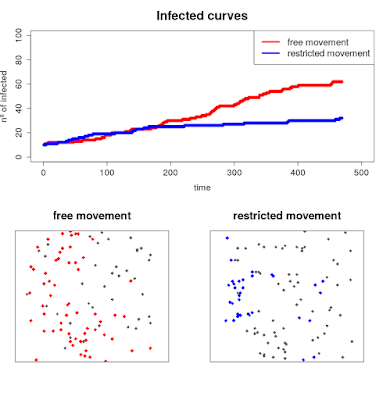Hi there,
This is the best meme I've found during these days...
Well, here it is my "BUT" contribution. Some weeks ago The Washington Post published this simulations about how "social distancing" could help to "flat the curve" of COVID-19 infections. I fell in love with these simulations because their simplicity and explanatory power. Indeed, you can use the pretty similar principles to simulate predator hunt behavior and other movement patterns... I wrote some R code to have a tiny version of them...
library(raster)
library(dismo)
r <- raster(nrows = 100, ncols = 100, xmn = 0, xmx = 100, ymn = 0, ymx = 100)
r[] <- 0
steps <- 500
n <- 100
locations <- data.frame(matrix(ncol = n, nrow = steps))
pp <- randomPoints(r,n)
cell <- cellFromXY(r, pp)
infected <- 1:10
pob <- 1:n
ratio <- data.frame(1:steps, NA)
pob_inf <- list()
for (j in 1:steps){
print(j)
locations[j,] <- cell
for(i in 1:n){
cell[i] <- adjacent(r, cell[i], 8)[round(runif(1,0.51,nrow(adjacent(r, cell[i], 8))+0.49),0),2]
}
new_inf <- cell %in% cell[infected]
infected <- pob[new_inf]
ratio[j,2] <- length(infected)
pob_inf[[j]] <- infected
}
locations2 <- data.frame(matrix(ncol = n, nrow = steps))
cell2 <- cellFromXY(r, pp)
infected2 <- 1:10
pob2 <- 1:n
ratio2 <- data.frame(1:steps, NA)
pob_inf2 <- list()
for (j in 1:steps){
print(j)
locations2[j,] <- cell2
for(i in 1:25){
cell2[i] <- adjacent(r, cell2[i], 8)[round(runif(1,0.51,nrow(adjacent(r, cell2[i], 8))+0.49),0),2]
}
new_inf2 <- cell2 %in% cell2[infected2]
infected2 <- pob2[new_inf2]
ratio2[j,2] <- length(infected2)
pob_inf2[[j]] <- infected2
}
Let's make some plots to put them together in a GIF and better visualize the results...
num <- seq(1,500,4)
for (p in 1:125){
id <- sprintf("%03d", num[p])
png(paste("corona_",id,".png", sep=""), width=780, height=800, units="px", pointsize = 15)
layout(matrix(c(1,1,2,3),2,2,byrow = TRUE))
plot(ratio[1:num[p],],pch=19, xlim = c(0,500), ylim = c(0,100), ylab = "nº of infected",
xlab = "time", col = "red", cex.axis = 1.4, cex.lab = 1.4, main = "Infected curves", cex.main = 2)
points(ratio2[1:num[p],],pch=19,col="blue")
legend("topright", legend = c("free movement", "restricted movement"),lwd = c(4,4), col = c("red","blue"), cex = 1.5 )
plot(r, col = "white", legend = FALSE, axes = FALSE, main = "free movement", cex.main = 1.8)
points(xyFromCell(r,as.numeric(locations[num[p],])), cex = 1.2, col = "grey40", pch = 18)
points(xyFromCell(r,as.numeric(locations[num[p],]))[pob_inf[[num[p]]],], pch = 18, col = "red", cex = 1.4)
plot(r, col = "white", legend = FALSE, axes = FALSE, main = "restricted movement", cex.main = 1.8)
points(xyFromCell(r,as.numeric(locations2[num[p],])), cex = 1.2, col = "grey40", pch = 18)
points(xyFromCell(r,as.numeric(locations2[num[p],]))[pob_inf2[[num[p]]],], pch = 18, col = "blue", cex = 1.4)
dev.off()
}
Done!
Stay safe!



How did you develop the plots?
ResponderEliminarCould you tell me the code for that too. Thank you for your response
Hi Jhonny,
ResponderEliminarThe code for the plots is the same that I'm using to create the animation (the animation is just many plots together). If you follow the full code, the static plot should be something like:
layout(matrix(c(1,1,2,3),2,2,byrow = TRUE))
plot(ratio[1:num[p],],pch=19, xlim = c(0,500), ylim = c(0,100), ylab = "nº of infected",
xlab = "time", col = "red", cex.axis = 1.4, cex.lab = 1.4, main = "Infected curves", cex.main = 2)
points(ratio2[1:num[p],],pch=19,col="blue")
legend("topright", legend = c("free movement", "restricted movement"),lwd = c(4,4), col = c("red","blue"), cex = 1.5 )
plot(r, col = "white", legend = FALSE, axes = FALSE, main = "free movement", cex.main = 1.8)
points(xyFromCell(r,as.numeric(locations[num[p],])), cex = 1.2, col = "grey40", pch = 18)
points(xyFromCell(r,as.numeric(locations[num[p],]))[pob_inf[[num[p]]],], pch = 18, col = "red", cex = 1.4)
plot(r, col = "white", legend = FALSE, axes = FALSE, main = "restricted movement", cex.main = 1.8)
points(xyFromCell(r,as.numeric(locations2[num[p],])), cex = 1.2, col = "grey40", pch = 18)
points(xyFromCell(r,as.numeric(locations2[num[p],]))[pob_inf2[[num[p]]],], pch = 18, col = "blue", cex = 1.4)
where "num[p]" should be any number between 1 and 500, it depends on the stage of the simulation you want to print.
Cheers